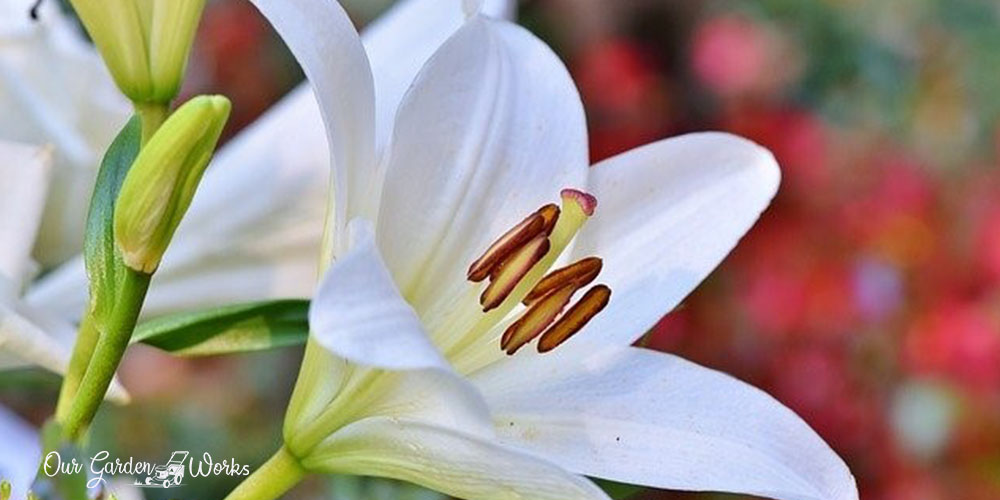Lilies are one of the most versatile flowering plants that you can grow both in water and soil. However, aside from its beautiful blooms, many novice gardeners are wondering what the seeds in lily blooms are for and how to harvest them from the plant.
In this post, we will share everything you need to know about lily seeds and how you can even turn them into a snack.
Lilies, depending on their variety, take a long time to grow from seeds. They are easy to grow from seeds but it takes a lot of patience for you to see the first set of flowers.
Usually, the first flower of lilies is grown from seed in one year. The other set of lilies will take another year to bloom and may even take three to seven years, depending on the climate and health of the plant.
(You could use the table of contents below to jump to the sections that are most important to you.)
How Do Lilies Produce Seeds?
Since gardeners take the test of time before they witness the beautiful blooms, it’s best to take advantage of the seeds that they will produce.
Like other flowering plants such as geraniums, lily seeds, and seed pods start to swell up as soon as the petals are spent.
Before the seeds form, your lilies will greatly appreciate a little bit of help by triggering their pollination process.
As we head on to pollinate the lilies, you should be familiar with the parts of the lily flower so it will be easier for you to follow the instructions later on in this post.
Parts of a Lily Bloom
To ensure that you will harvest good seeds when the lilies develop, you have to perform a cross-pollination between the flowers of the same species. The crucial parts during the cross-pollination process are the following:
- Anther: The part that contains the visible and powdery orange pollen grains. It is the iconic part of lily blooms that sets it apart from other flowers.
- Stigma: Stigma is connected to the main body of the flower where the ovary is located.
- Ovary: The ovary of the flower will start to swell up as soon as the petals wilt and start developing the lily seeds.

How To Cross-pollinate Lilies To Promote Seeding?
Now for the fun part, check out the steps below to self-pollinate your lilies to speed up their seeding process.
(1) Check the lily bloom and look for its anthers. Cut one anther by pinching or using pruning shears.
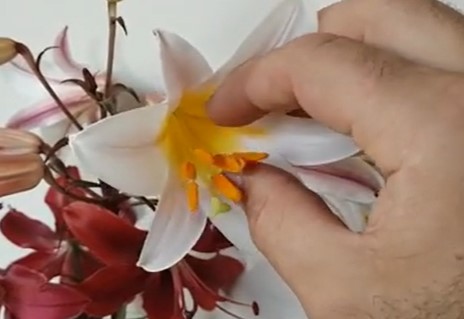
(2) Look for the stigma or the green stalk that sticks out among the anthers of another flower of the same variety. Rub the powdery pollen to the stigma. After several weeks, the ovary will start developing the seeds and expand.
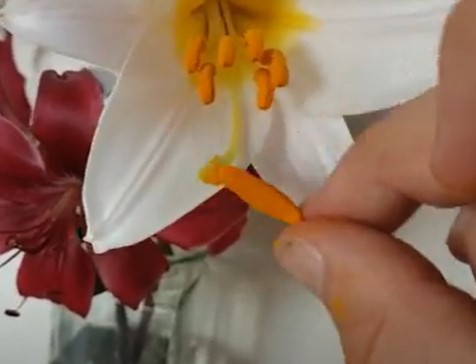
What Do Lily Bloom Seeds Look Like?
Lily bloom seeds are small black seeds that are slightly bigger than peppercorns. Some varieties like Trumpet Lilium Regale, however, are orange and shaped like a bean and as thin as a petal.
The best indication of such seeds, if they are viable for planting, is when there is an embryo present on the seed which looks like a small line at the center.
Different lily seeds: (Check pictures below)
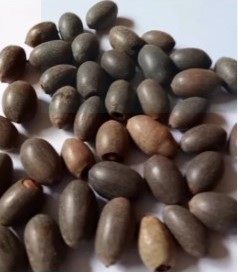
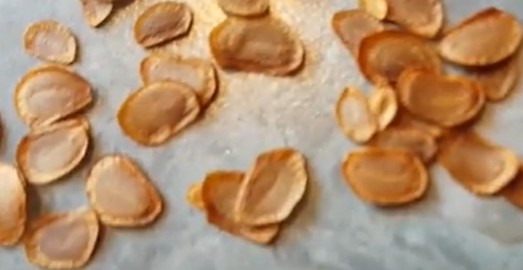
How To Harvest The Lily Seeds?
Harvesting the lily seeds usually comes after the seed pods have started to open and give you a peek of the black seeds.
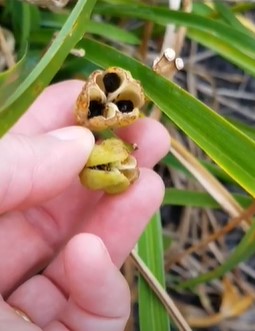
The seed pods are not yet visible when the flower is currently in its blooming phase. As the flower starts to wilt and the stigma has been pollinated, the ovary will slowly start to swell.
At first, you will notice the seed pod swelling but remain closed. This means that the seeds are already formed but are not yet mature enough to be harvested. Lilies have a way of communicating to green thumbs by popping open when the seeds are nearing seeding maturity.
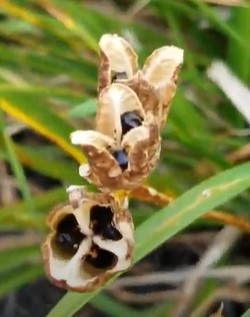
The perfect time to harvest the lily seeds is when seed pods dry up and turn brown. Using pruning shears or by hand, you can remove the seed pods to collect the mature seeds. They are pretty easy to remove once the seed pods are dry so make sure to have a tray or tissue ready so the seeds won’t fall out of anywhere.
Your newly harvested seeds can be stored for your future lily planting. However, if you wish to plant them immediately, you must first do the stratification process to prep the seeds for the planting process.
The Stratification of Lily Seeds
Stratification is a process that mimics the natural pre-winter conditions to treat the seeds before the germination phase.
Lily seeds need to undergo the stratification process for about 2 to 3 weeks to make sure they will germinate properly.
How to place your lily seeds under stratification?
Lilies take a different kind of care starting from the moment that you prepare the seeds for planting.
Here’s how you can treat your newly harvested seeds for planting:
Materials:
- Paper towel
- Spray mist
- Ziplock bag
Directions:
(1) Place the seeds in tissue paper a few inches apart. You may place as much as you want, given that they fit enough to the tissue paper. Make sure that the seeds you’ll treat for stratification are the number of lilies that you want to plant. Otherwise, place them in a jar for future use.
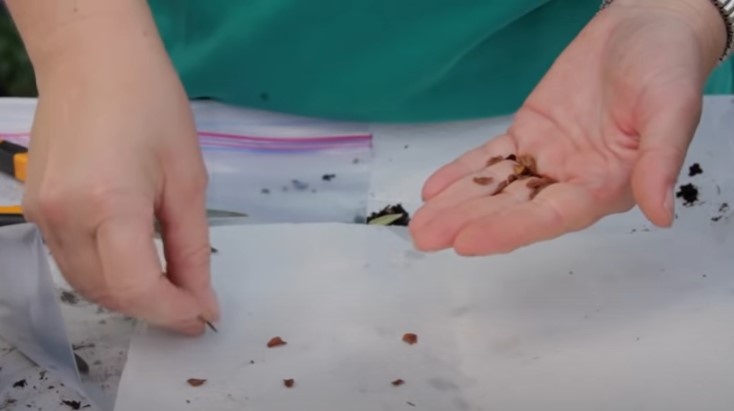
(2) Spray water on the seeds laying flat on the tissue paper. Make sure that the seeds are damp but not dripping wet.
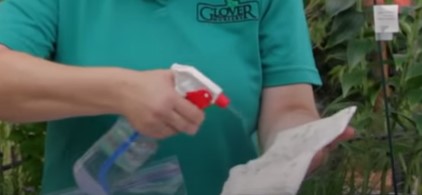
(3) Once done, cover the tissue paper with seed with another sheet of tissue paper. The cover will ensure that the seeds will stay in place and provide better temperature control to the seeds.
If the tissue paper is too big for what you need, you may just simply fold a large tissue paper to cover the seeds.
(4) Spray water on the tissue paper and make sure that the tissue is moist enough.
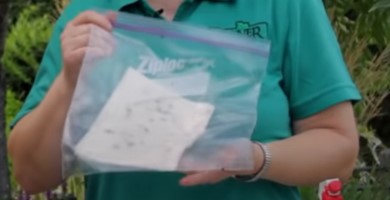
(5) Place the tissue paper in a ziplock to keep them safe and undisturbed. Some gardeners no longer place the tissue paper in a ziplock bag but still get the same results. However, if you feel that the seeds will be disturbed when placed in the fridge, it’s best to place them in a plastic bag.
(6) Place the plastic bag in the fridge for 3 weeks or 3 months, depending on the lily variety. You can either tape the bag on the door of the fridge or simply place it on top of the fridge tray. Set the temperature below 50 degrees Fahrenheit.
(7) After 3 weeks or months, you may start planting them in a seedling tray. The best time to plant the lily seeds is during fall.
Benefits of Lily Seeds
Believe it or not, your lilies can give you a bag of seeds as soon as their flowers are spent. The first benefit of having the seeds on your terms is that you no longer need to buy seeds and propagate them on your own.
With how many seeds they provide in every bloom, you can achieve a collection of seeds from every variety. You can plant them anywhere and anytime you want.

Lastly, some varieties of lily seeds can be a good alternative to your popcorn and a good addition to your favorite stew. Euryale Ferox or the prickly water lily is a popular variety of lily that provides edible seeds.
It is commonly known as any of the following:
- Fox nuts
- Lotus seeds
- Gorgon nuts
- Phool makhana
- Makhana
The popped fox nuts are a popular snack in the northern part of Asia. Unpopped fox nuts, on the other hand, are a great addition to dishes like the makhana curry.
Harvesting the edible lily seeds is different from the seeds you’ll find in the garden. They are usually the lilies you’ll find in ponds and take a tedious process to collect from the plant. The makhana seeds also undergo a lot of processes before you can eat them.
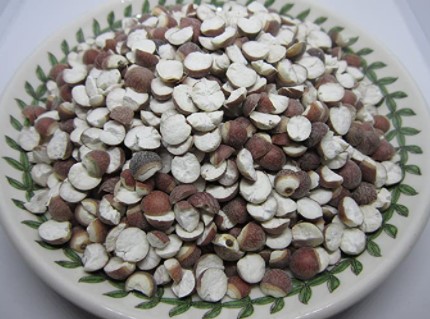
When To Plant Lily Seeds?
The best time to plant lily seeds greatly depends on the germination necessary for its variety.
There are two types of germination for lilies namely, epigeal germination and hypogeal germination. The seed preparation mentioned earlier in this post is under epigeal germination.
For varieties requiring hypogeal germination, having a good amount of patience is necessary.
The lily seeds under this process start by placing the seeds in peat moss inside a plastic bag at a warm temperature. When the first bulb shows up, it will take another 3 months of treatment in the fridge before sowing the seeds in the soil.
The waiting period for the first bulbs to appear, which is the hard part, is approximately 4 years and above.
How To Plant Lilies?
Once the bulbs are starting to emerge during the germination stage of your lilies, you may start preparing the soil.
Lilies like well-draining soil because the bulbs may rot if water gets clogged in the soil. Depending on the variety, they also like acidic to neutral soil. However, some are tolerant of alkaline soils.
When you’re done mixing the soil for the lilies, here are the steps to planting the lilies:
- Lilies need a depth of 12 to 15 inches in the soil to promote a stable anchorage to the roots and stem.
- Water the newly planted seeds thoroughly and place them in a location where they can get full sun for 6 to 8 hours.
- Water them weekly with approximately 1 inch of water and fertilize them with a fertilizer rich in potassium every 2 weeks.
- Place a mulch on the soil to help maintain the soil moist and control the soil temperature.
- Before the first frost, you should add 2 inches of soil mulch. Then, as the ground warms up in spring, you may gradually lessen the mulch into a thin layer as the climate warms up.
- After 18 months, the first bulbs will show up and enjoy the beautiful blooms later in the growing season.
Pro tip: To promote the bloom production of your lilies, make sure to remove the spent flowers to divert the energy of the plant in producing more bulbs than developing seeds.
Lily Seeds As a Snack: How To Eat Lily Seeds As a Snack?
If you are curious about having the lily seeds as a crunchy snack, you may now buy them like your usual Cheetos or in an unpopped form.
However, popping the makhana or lily seeds is very tedious. The seeds are heated and popped by hitting them with a wooden plank.
Unlike popcorn that pops on its own, lily seeds require an external force to break the outer shell and pop. The makhana or fox nuts, however, can be bought unflavored. You may roast them however you like and add new flavors.
Popped makhana seeds are a popular snack among the vegan community and are used as an alternative to popcorn.
Some manufacturers eased this process by providing ready-to-eat fox nuts:
- Taali Himalayan Pink Salt Water Lily Pops
- Swaha Popped Water Lily Seeds – Vegan Protein Snacks
- Unflavored Swad Phool Makhana – Puffed Lotus Seeds
How To Roast Lily Seeds?
If you bought unflavored lily pops, you may roast them with salt and other spices using your oven or pan. Here, we will share how you can roast these delectable treats in a pan.
Ingredients:
- 3 cups of makhana
- ¼ tsp. turmeric powder
- ½ tsp. red chili powder (optional)
- rock salt
- 2 to 3 teaspoon butter or olive oil
- ½ tsp. red chili powder (optional)
Directions:
- Pre-heat a wok or pan.
- Dry roast the makhana or fox nuts for 10 to 15 minutes until they are crisp.
- Turn off the heat and sprinkle the spices on the roasted makhana. The oil will help the seasonings stick to the lily pops.
Final Thoughts
We hope that this post has helped you learn more about the incredible features of lilies. Lilies may take a lot of patience to grow but with rewarding elegant blooms and a ton of seeds in every growing season.
Let us know in the comments if we helped you know where the seeds are in lily bloom and how you can germinate, plant, and even eat them.
Also, please don’t forget to share this post with your friends and spread the unique way of growing lilies from seeds.
